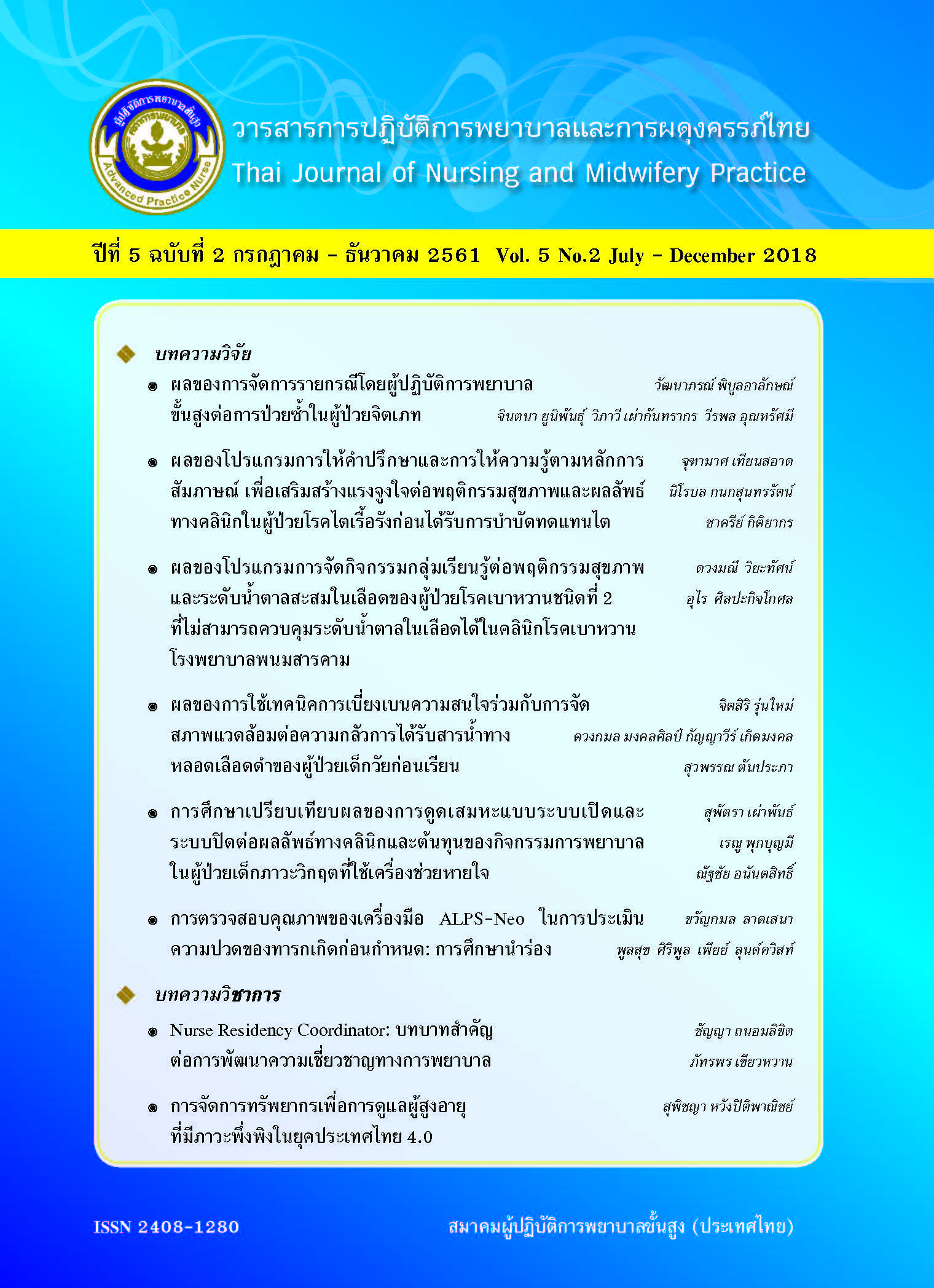Effect of Distraction Technique and Environmental Design on Fear of Intravenous Fluid Administration in Preschool Aged Children
Main Article Content
Abstract
Intravenous fluid administration is a nursing intervention faced by hospitalized children patients that resulting in fear particularly in preschool aged children. This quasi-experimental study aimed to compare the effect of intravenous fluid administration using conventional technique and using distraction technique with environmental design on fear in preschool aged children. Subjects were 80 children with ages ranged from 3 to 6 year old. They were administered with intravenous fluid and were divided into two groups: control and experimental groups. Control group received conventional intravenous fluid administered and experimental group received distraction technique and environment design modification method. Instruments used were: data recording form, observing fear behavioral observation form, and interview questionnaires on caregiver’s satisfaction. Data were analyzed using independent t-test. Results revealed that the experimental group had a statistical significant lower level of fear than the control group (p<.05) and the caregivers of the experimental group had a statistical significant higher satisfaction than the caregivers of the control group (p<.05). This study suggested that using distraction technique with environmental design could reduce fear among preschool aged children receiving intravenous fluid and increase satisfaction among caregivers.
Downloads
Article Details
References
New York: Churchill Livingstone; 1997.
2. Whaley LF, Wong DL. Nursing care of infants and children. 6th ed. Philadelphia: Mosby; 1999.
3. Josselyn IM. Psychosocial development of children. 1st ed. New York: Family Service Association of America; 1978.
4. Kasemsook C. The effect of concrete objective information program on fear of aerosol therapy of preschoolers with acute respiratory infection. Journal of Nursing Science Chulalongkorn University 2011; 23(3): 96-106.
5. Sangnimitchaikul W. The effect of preparation for hospitalization on fear of preschool children. Journal of Nursing Council 2007; 22(4): 38-49.6.
6. Boonyawatanangkol K, Putisawat W, Pri K, Kasertwatin S, Parklumyong T, Supakunpinyo C. Distraction as a technique to control pain in pediatric patients during venipuncture. Journal of Nursing Science and Health 2006; 31(2): 21-29.
7. Sirichai Pongwichai. The Statistical analysis. 22nd ed. Bangkok: Chulalongkorn University; 2009.
8. Keidmongkon K. The effect of giving concrete objective information with maternal participation on fear of intravenous infusion among preschoolers Journal of Nursing Science Chulalongkorn University 2012; 28(2): 25-34.
9. Carr TD, Lemanek KL, Armstrong FD. Pain and fear ratings: Clinical implications
of age and gender differences. Journal of Pain and Symptom Management 1998; 15: 305-13.
10. Patel DR. Rowlett J, Presenting problem in behavior disorder. In: Donold EG, Mark LW, editors. Behavior pediatric. 1st ed. New York: Springer-Verlag; 1995. P.100-01.
11. Junaim S. Phychology of juvenile. 4th ed. Bangkok: Thaiwattana Printing; 2000.
12. Johnson JE. Self-regulation theory and coping with physical illness. Research in Nursing and Health 1999; 22: 435-48.
13. Wong DL. Whaley and Wong’s nursing care of infant and children. 6th ed. Philadephia: Mosby-Year Book; 1999.
14. Piaget J. The child and reality. 1st ed. New York: Crossman Publishers; 1973.

